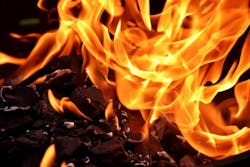A new wave of fires that erupted over Labor Day weekend in California.
According to NPR, California officials warned residents in Sonoma County to remain vigilant after more than a dozen fires erupted Aug. 6. South Lake Tahoe's 22,000 residents had their mandatory evacuation lifted after making progress containing the Caldor Fire, which remains only 48% contained, reported ABC7News.
The 338 square-mile Caldor wildfire crossed the Sierra Nevada last week. The Caldor Fire erupted Aug. 14 and was burning as many as 1,000 acres an hour at its peak. Bulldozing defense lines and air-dropping Lake Tahoe water onto the flames allowed response crews to carve a perimeter around much of the wildfire, reported ABC7News.
Director of the Tahoe Environmental Research Center at UC Davis Dr. Geoffrey Schladow said their researchers were working to see the effects of the fire on the water in Lake Tahoe, as smoke and ash particles entered the water as a result of the fire, reported FOX40 News.
Additionally, State Sen. Mike McGuire tweeted that several "suspicious" fires started over the course of the evening, reported NPR. Firefighters stopped most of the forward progress on these multiple fires, according to McGuire, reported NPR.
Other fires that cropped up are: the Lawrence Fire, the Bridge Fire, and the Aruba Fire
Evacuation orders for South Lake Tahoe were downgraded to evacuation warnings after the Caldor Fire reached 44% containment.
The Caldor Fire has been active for 22 days, burning 216,358 acres, reported Cal Fire. At least 965 buildings were destroyed in the blaze and another 76 damaged, reported NPR. No deaths have been reported specifically from the fires, and the National Weather Service in Oxnard, California, said hot dry weather was expected for interior valleys and deserts with elevated fire conditions through Aug. 10.
According to the National Weather Service some parts of California could reach 110 degrees through the rest of the week.
According to The Los Angeles Times, scientists are using research boats, buoys, underwater robots and other instruments to collect data on: water clarity, temperature, concentrations of algae, tiny smoke and ash particles, and other metrics to understand the impacts of the fires.
Additional threats to water quality could occur when rain falls or snowpack melts, and erosion in burn areas could send more runoff into the lake, degrading water quality, reported The LA Times.


